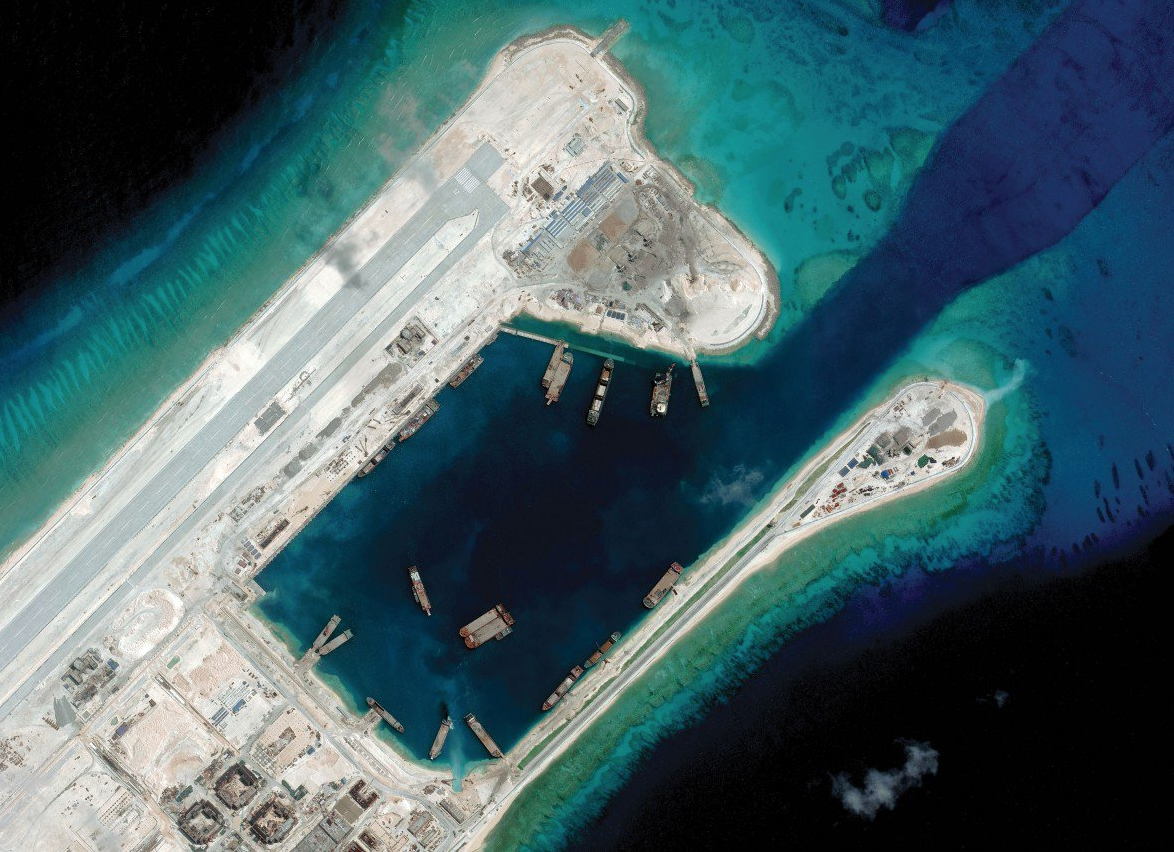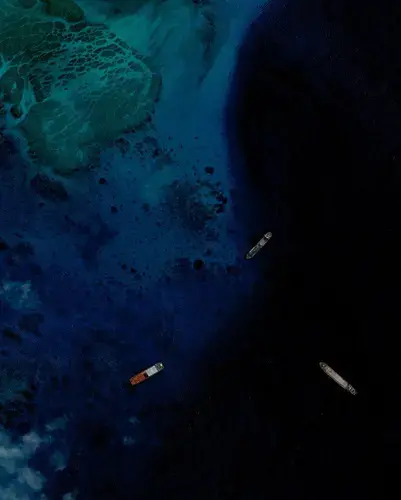
Fifteen miles out on the water south of Biloxi, Mississippi, below a cloudless sky, a foaming torrent of gray-black slurry gushes into a ship. Every three seconds, another truckload’s worth of salt water and sand, siphoned from the bottom of the Gulf of Mexico, pours into the Ellis Island’s vast, open cargo hold, called a hopper. The ship is gargantuan—the biggest such dredge ever built in the United States. Its progress is, by design, slow. It is hauling a pair of 30-ton drag heads, studded with steel teeth, which scrape along the sandy sea bottom. Twin pipes, each three feet (90 centimeters) in diameter, connect the drag heads to giant pumps on the ship’s deck. The pumps suck slurry into the hopper, which slowly fills with roiling gray soup, speckled with muculent, softball-size bubbles.
“We call ourselves dirt merchants,” Gabriel Cuebas, the Ellis Island’s captain, told me when I visited on a hot October day. His ship is 433 feet (132 meters) long—a good bit longer than an American football field and about half the length of an aircraft carrier. Twin yellow cranes perch on either side of the deck. Their metal bulk towers over a maze of catwalks and pipes that surround the hopper.
It takes several hours for the hopper to fill with slurry. Once that is done, enormous winches haul up the drag heads, and the ship sets course toward the mainland. An hour or so later, the Ellis Island drops anchor several miles offshore, in water deep enough for its 30-foot draft. An assembly that looks like an eyeless robotic sea serpent bobs in the waves. Crew members get a rope around the serpent’s head and winch it out of the water. They connect the serpent to a pipe leading from the hopper. The ship’s pumps kick in again, pulling slurry back out of the hopper and shooting it down a mile of pipe to a floating booster station, where more pumps will usher it along. The sand will travel through almost five miles (eight kilometers) of pipe before it is finally blasted onto the shore of Ship Island.
Ship Island is, for the moment, actually two islands. What was originally its center was eroded by hurricanes: Camille in 1969 and Katrina in 2005. (It was spared the worst of 2018’s Hurricane Michael.) The US Army Corps of Engineers, the federal agency charged with maintaining America’s waterways, has hired the Ellis Island to help rebuild the eight-mile-long island, an important bulwark against increasingly severe storm surges.
Once this load of sand has been discharged, the Ellis Island will head back out for another, and then another, around the clock, day after day. The whole job will take about a year, during which a relay of ships will move enough sand to bury the real Ellis Island 50 yards deep: 7 million cubic yards (5.4 million cubic meters) of it. The total cost of rebuilding Ship Island, to be paid by the federal government, will be some $350 million.
It is a colossal operation. But compared with what China is doing, it’s a drop in the ocean.
In China as elsewhere, dredging is used to build protective barriers against the rising seas, as the Ellis Island is doing, and to create valuable new real estate. But for China’s president, Xi Jinping, it is also an important geopolitical tool. Today, more than ever, dredges have the power to create land where there was none, altering the shapes of coastlines and the contours of countries. No nation has cultivated this power more zealously than China.
In recent years, China has assembled an armada of oceangoing dredges. Some it buys from Japan, Belgium, and the Netherlands. Increasingly, though, China manufactures them itself. China’s homemade dredges are not yet the world’s largest, nor are they any more technologically advanced than those of other countries, but it is building many more of them than any other country. In the past decade, Chinese firms have built some 200 vessels of ever greater size and sophistication. In 2013, Rabobank, a Dutch firm, declared that China’s dredging industry had become the biggest in the world, and it has only grown since then. Chinese firms bring in as much revenue from domestic dredging as is accrued in all of Europe and the Middle East combined.
Since 1985, according to Deltares, a Dutch research group, humans have added 5,237 square miles (13,564 sq km) of artificial land to the world’s coasts. China is a major—and growing—contributor to that total.
Most plant and animal life on the seven Spratly reefs was destroyed by the mountains of sand dumped atop the coral.
In 2015 alone, China created the equivalent of nearly two Manhattans of new real estate. In recent years, it constructed two artificial islands to support a 34-mile-long bridge that connects Hong Kong with Macao and the Chinese mainland; it opened in October 2018 and is the world’s longest sea crossing. Much of that work was carried out by state-owned CCCC Dredging, the world’s largest dredging firm. By way of comparison: In 2017, Great Lakes Dredge and Dock, America’s biggest, took in an estimated $600 million from dredging operations. CCCC Dredging booked $7 billion.
Manufacturing land is not a new practice. The Dutch have been creating new territory since the 11th century by damming wetlands and pumping them dry. Peter Stuyvesant, the first governor of what would come to be called Manhattan, expanded the island with earth displaced by the construction of buildings and canals. Land reclamation, as the practice is called even when the “reclaimed” land is entirely new, has long gone hand in hand with dredging’s other main purpose—clearing paths for ships to travel in.
Today the industry’s basic tool is the centrifugal pump. It is something like a blender bisected by a garden hose. A motorized drive shaft spins an impeller. The impeller’s spin pulls liquid (and sand) through the pipe. First introduced in the 1860s, these pumps enormously increased the amounts of sediment that can be siphoned from the ground under the sea. They also make it possible to pump the stuff through miles of pipeline to distant destinations.
As steam power gave way to diesel in the late 19th century, the size and power of dredges grew. Developers in Los Angeles used centrifugal pumps to expand the city’s port and turn marshlands into seaside real estate. Sediment dredged from underwater built Boston’s Back Bay, as well as large portions of Marseilles, Mumbai, and Hong Kong.
Beginning in the 1970s, oil-exporting countries in the Persian Gulf plowed their surging wealth into developing huge new ports, which spurred dredging companies to bring larger, mightier ships to market. For coastal megalopolises long on population but short on waterfront, land reclamation offers a way to add room. Hong Kong and Osaka, Japan, both built new international airports on artificial islands in the 1990s. Many of the world’s largest artificial islands are either in the Middle East, such as Dubai’s famous palm-tree-shaped islands, or off the coast of Japan. But that is changing.
The Chinese government declared dredging a “priority growth area” in 2001, as part of a push to increase China’s maritime power. At the time, the country’s dredging fleet consisted of aging, outdated ships. Chinese companies were capable of building only relatively small vessels. With the government’s support and investment, capabilities boomed. In the past 15 years, Chinese companies have built scores of the main types of giant dredges: trailing suction hopper dredgers—“trailers” for short—and cutter suction dredgers.
Trailers like the Ellis Island gather sand while on the move. Their drag heads break up loosely compacted sea-bottom sands, which are then vacuumed up and stored in the ship’s hoppers for transport. In 1965, the biggest such dredges could hold about 6,500 cubic yards of material. That number more than tripled by 1994; by now, it has grown nearly tenfold. The world’s two biggest dredges, the Cristóbal Colón and the Leiv Eiriksson, were built in Spain for Belgium’s Jan De Nul Group in 2009 and 2010. They are identical twins. Stood on end, each would rise higher than a 60-story skyscraper. They can carry about four times as much sludge as the Ellis Island.
Cutter suction dredgers, meanwhile, anchor in areas where the sea bottom is too hard for trailers. A boom arm capped with a cutter head—a tooth-studded steel ball the size of a wine barrel—protrudes from the bottom of the ship. The ball spins around, tearing up sand, rocks, and whatever else it finds on the seabed, while a suction line behind it hoovers up the grains. The material is then pumped onto a barge, or sometimes straight into a pipe leading to the land reclamation site. Cutter suction dredgers’ might is measured by their installed electrical power, which has also grown exponentially in recent decades. The most potent generate and consume more than 40 megawatts—enough to power 30,000 American homes.
In 2017, CCCC Dredging launched the Tian Kun Hao, Asia’s biggest cutter suction dredger, which was built entirely in China. It is about the same size as the Ellis Island, or about a quarter the size of the Belgian behemoths, and can suck nearly 8,000 cubic yards of sand and other material per hour from depths up to 100 feet.
CCCC Dredging has begun taking on projects overseas, and it now operates in dozens of countries. It has a particular focus on places targeted for Chinese-led port development as part of Xi’s Belt and Road Initiative.
China’s land reclamation work will have tremendous economic consequences in coming years. Its political consequences are already profound.
The South China Sea is one of the world’s busiest shipping routes. What’s more, billions of barrels of oil and trillions of cubic feet of natural gas lie under the seafloor. So it’s no surprise that every country in the region—China, Taiwan, Vietnam, Brunei, Malaysia, and the Philippines—lays claim to parts of the Spratly Islands, a scattering of rocks and reefs in the middle of the sea, 500 miles due east of Vietnam and 200 miles southwest of the Philippines.
China controls seven naturally occurring Spratly outcroppings (one of which it seized from Vietnam in a 1988 clash that left dozens of soldiers dead). It is using its industrial might to create new facts in the water. Starting in late 2013, the Chinese government set dozens of CCCC Dredging’s ships to work. Within 18 months, these ships added nearly 3,000 acres (1,200 hectares) of new land to the Spratlys, enough to fit three copies of New York’s Central Park with room to spare.
Almost as soon as the sand was dry, China began turning the new islands into military bases.
Almost as soon as the sand was dry, China began turning the new islands into military bases. It installed antimissile weaponry, runways capable of handling military aircraft, structures apparently designed to house long-range surface‑to‑air missile launchers, and port facilities for warships. China has also built new territory in another tiny collection of South China Sea islands called the Paracels, where it has similarly installed airstrips and missile batteries.
This expansion of Chinese power into the Pacific has alarmed the US as well as China’s neighbors. To show it does not recognize the new islands as Chinese territory, the United States has made a point of flying B-52 bombers over them and sending warships to pass close by. For its part, China has landed long-range bombers on its new runways, as a show of force.

Tensions spiked in late September 2018, when the Lanzhou, a Chinese destroyer, cut across the bow of the USS Decatur, an American destroyer. The Decatur’s captain slammed the ship’s engines into reverse, averting a collision by only 45 yards—a quarter of the length of his ship. The incident took place just a few miles away from some of the new artificial islands.
It may be too late for other nations to do much about China’s artificial-land grab. Admiral Philip S. Davidson, head of the US Indo-Pacific Command, told Congress in April (shortly before assuming his command) that “China is now capable of controlling the South China Sea in all scenarios short of war with the United States.”
All that island building has also caused “devastating and long-lasting damage to the marine environment,” according to the Hague-based Permanent Court of Arbitration, which rejected China’s claim to sovereignty over much of the South China Sea in 2016. Most plant and animal life on the seven Spratly reefs was destroyed by the mountains of sand dumped atop the coral. John McManus, a University of Miami marine biologist, called it “the most rapid rate of permanent loss of coral reef area in human history.”
Other land reclamation projects have inflicted similar, albeit smaller-scale, damage. They have destroyed or damaged coral reefs and oyster and seagrass beds in Dubai, Bahrain, and other Gulf countries, as well as killing marine life. In the US, dredges are required to make sure they’re not sucking up turtles and other sea creatures; if they do, they have to stop work until they address the problem. Environmental concerns are one reason why, while China is feverishly building new land, land reclamation in the US is just what it sounds like—confined almost exclusively to counteracting the erosion of previously existing land. “In Bahrain, if we found a turtle we’d just throw it back over the side,” says Brian Puckett, a Great Lakes executive who oversees the Ship Island project.
Puckett is proud to show off pictures of the islands he helped create for real estate developers in the Persian Gulf. “It’s amazing to be able to show them to people on Google Earth and say, ‘I built that,’” he says. “That was part of the reason I came to work with Great Lakes. I want to work on projects that are important.”
Island building, as China has shown, is one of the most important projects there is. Today, geopolitical power goes not only to those who control territory but to those who can manufacture it.

Education Resource
Meet the Journalist: Sim Chi Yin
The world is running out of sand. It seems counter-intuitive but the sand, besides air and water, is...






